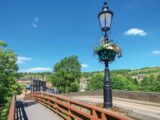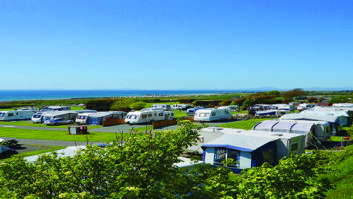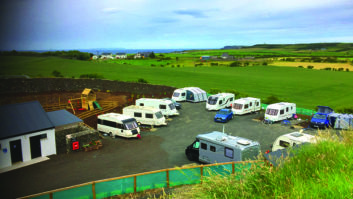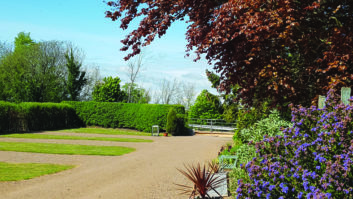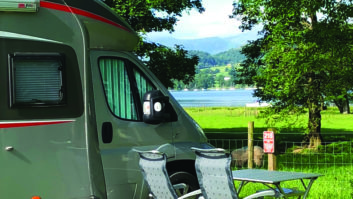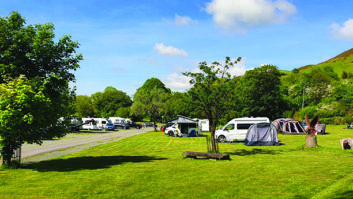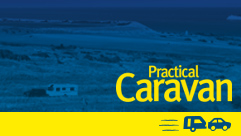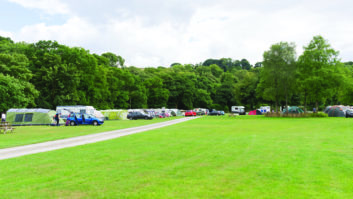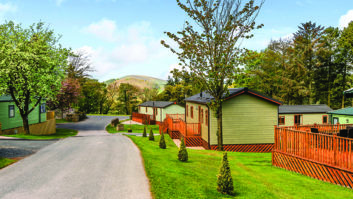We fancied a long weekend away to take advantage of a good weather forecast, so we headed for the Yorkshire Dales. Our chosen destination was Pateley Bridge, in Nidderdale Area of Outstanding Natural Beauty.
It really is beautiful, so when you visit, prepare to enjoy the splendid views (check out our guide to campsites with stunning views for more too).
We based ourselves at Riverside Caravan Park, a short walk from the town. The site offers a mixture of hardstanding and grass pitches, all with 10A power supply and a few fully serviced. Riverside is beautifully kept, with a good amenities block and reception, something that many of us look for when choosing the best caravan parks for our tours.
Adjacent to the touring pitches is a large area housing static caravans, but these were mostly unoccupied when we visited, so the place was especially quiet and peaceful.
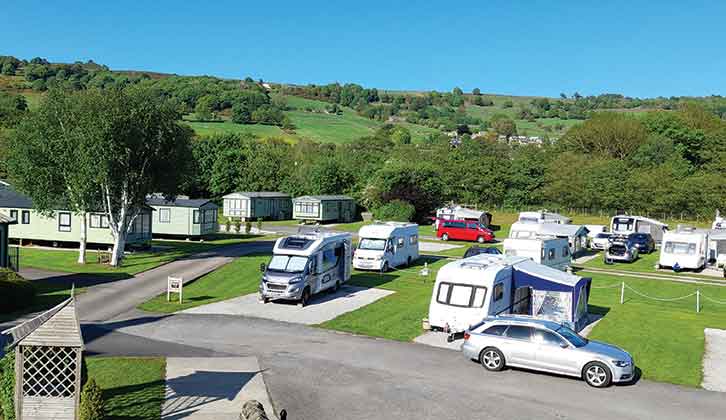
Heritage walking trails
We’ve visited Pateley Bridge before, but don’t know the area very well, so we were keen to explore on the Saturday morning.
A pretty riverside footpath runs past the site, and this soon leads you into Pateley Bridge. Even a relaxed saunter would get you onto the main street in 10 minutes.
I had done a bit of research before arriving and downloaded a couple of walks to explore Pateley Bridge and the surrounding area.
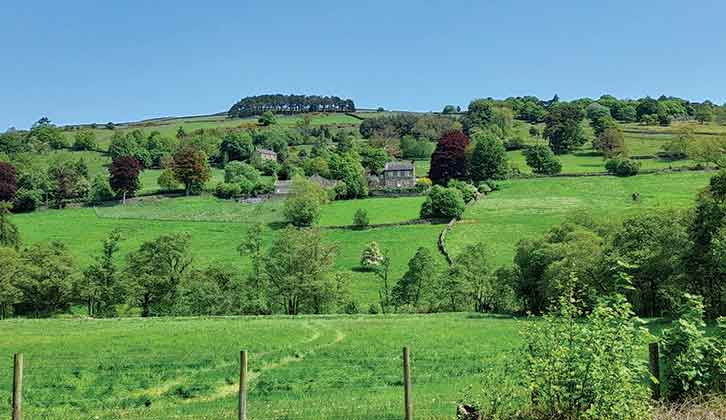
The Pateley Bridge Heritage Trails are two excellent walks: the Inner Trail, a short route around the town, and the Outer Trail, which takes you further afield (and up a steep hill).
We stopped to enjoy the view several times on the way – that was our excuse, anyway. We should have known what to expect when the trail advises you to follow the sign for the Panorama Walk! Actually, on the way up the hill, the view is obscured by trees and bushes, so perhaps ‘panorama’ is a bit of a misnomer.
St Mary’s Church
After climbing the hill, you reach a cemetery on the left, which is the ‘new’ cemetery, where most of the gravestones seem to date from the late 19th century. There are more amazing views over the town from here.
Just past there, on the left, you come to a small gate and a footpath leading to the ruins of the ancient church of St Mary’s. This hidden gem was the highlight of the walk for us.
The church dates back to the 14th century, although it is possible that a place of worship stood here long before then.
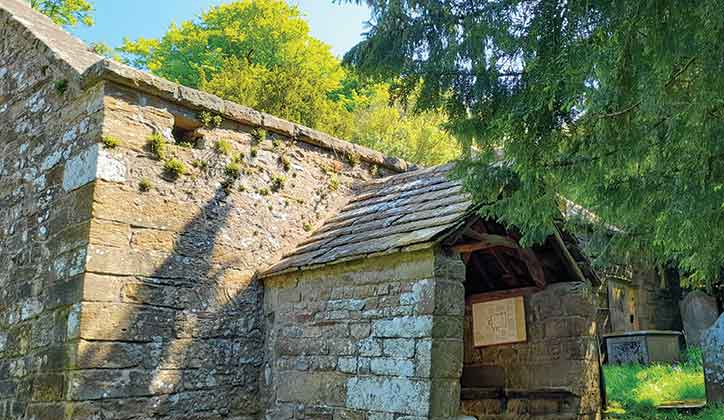
The tower was built in the 16th century and is still standing, but the main part of the church now has no roof. It stands in a pretty wooded glade and the sunlight filters through the ancient yew trees and into the ruins.
There are interesting gravestones here, too, dating back to the 18th century. One states that Mary Ann Myers died at ‘nigh on 120 years’! This is a peaceful, tranquil oasis.
The Church of St Mary’s was in use until 1826, when it was deemed too small and difficult to reach (did I mention the hill?), so a new church was built in the town.
After spending some time absorbing the peace of the churchyard, we attempted to find the path again, but at this point, things went a bit awry. Having only downloaded the trail onto a phone, it was a struggle to see the route properly and the onward path was not obvious to us.
A further climb uphill was vetoed so we took a quiet road downhill, which turned out to be Old Church Lane and brought us to the area called Bedlam and back into town.
Further research when we got back to the land of Wi-Fi revealed that the name Bedlam was likely from the Old English ‘at the buildings’, rather than any link with London’s 17th-century Bedlam hospital.
The Outer Trail is quite strenuous and coming down again played havoc with our knees – but the views really are spectacular.
Medieval market town
On returning to Pateley Bridge, we availed ourselves of lunch in one of the many cafés and then set out on the Inner Trail.
The town has just the one main street, but there is a wealth of history here. It has been a market town since the 14th century, although the area was settled hundreds of years before that.
In the 19th century, it supported local industries, including lead mining and the quarrying of sandstone. The Heritage Trail highlights important buildings throughout the town, giving details of their history.
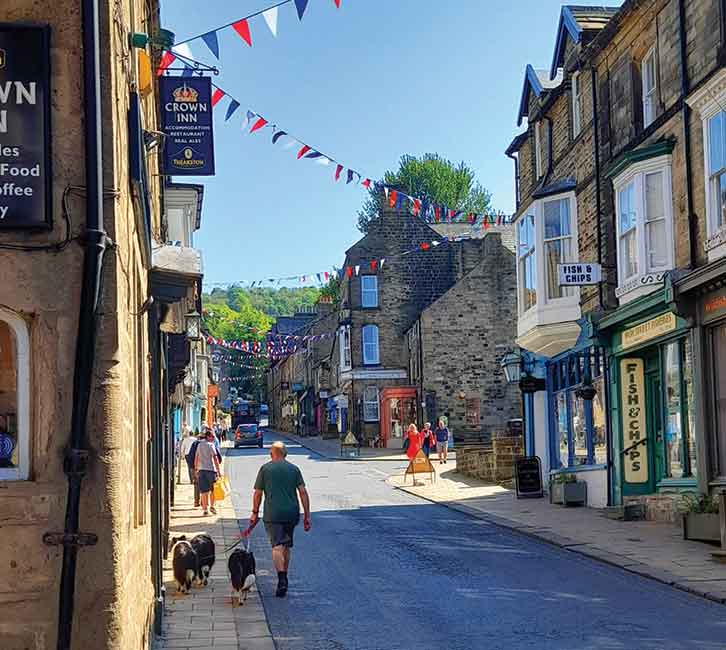
Some of the oldest buildings are from the 17th century, such as the Pateley Club, which was originally built in 1664 as The George and Dragon Inn.
After walking around town, we stopped in at Nidderdale Museum, housed in the former workhouse. It is well worth a visit, with its huge collection of items depicting life in Nidderdale over the past 200 years, all displayed in historic settings, such as a parlour, a shop and a typical schoolroom.
Dales National Park
The following day, we went to Grassington on the 822 DalesBus service, which runs every Sunday from May to October. There’s a car park in the National Park Visitor Centre, but it is often busy and on a May Sunday, we would later see motorists struggling to find parking spaces.
It is only a 20-minute journey on the bus and also meant we could both appreciate the amazing scenery, rather than one of us concentrating on driving and missing it!
Grassington, in Wharfedale, is a good place to start exploring the Yorkshire Dales National Park. Lots of footpaths lead into the Dales from there.
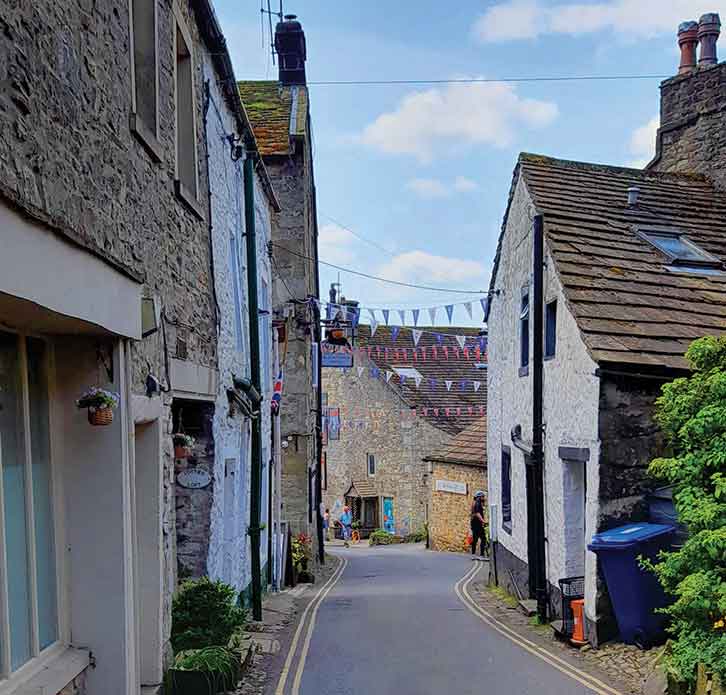
The village is picturesque and attracts visitors all year round. In December, there is a Christmas market, with stallholders dressed in costume (although that seemed a long way away on a May afternoon!).
The bus drops you at the National Park Visitor Centre, a short walk from town. Alternatively, you can follow the footpath through the car park down to the River Wharfe, take a look at the imposing Linton Falls and enjoy a walk along the river.
We were getting hungry by then, so we decided to head into town for something to eat. There are plenty of cafés and a few pubs to choose from, and we enjoyed a lovely Sunday roast.
The recent remake of All Creatures Great and Small for Channel 5 was filmed in and around Grassington, so the town will be familiar to those who have watched it. But it has always been a magnet for visitors, from people interested in a leisurely stroll to appreciate the town and its stunning views, to more serious hikers who can start and finish several excellent treks here.
After lunch, we had a gentle walk along the main street and around the cobbled market square, which was lined with small shops and stalls selling cheeses, cakes and various other tempting treats.
On our way back, we paused to visit the Grassington Folk Museum, a charming local museum run by volunteers, which is free to enter and has a fascinating collection.
A pair of fine mills
The following day, we decided on a walk from the caravan park. We took the path by the site, turning away from the town this time. The countryside is spectacular.
After following the trail by the river for a while, the path disappeared, so we took another footpath through a field, noticing a pub, The Bridge Inn, over to our left.
It was closed, but next door is a fine old watermill. Later research revealed that this is the Foster Beck Water Mill, built in 1860, with a large waterwheel that was installed in 1904. Twine and linen yarns were its staples for spinning and it remains a fine reminder of the area’s industrial past.
The mill closed in 1966 and was later a pub and restaurant, but more recently has been converted into accommodation.
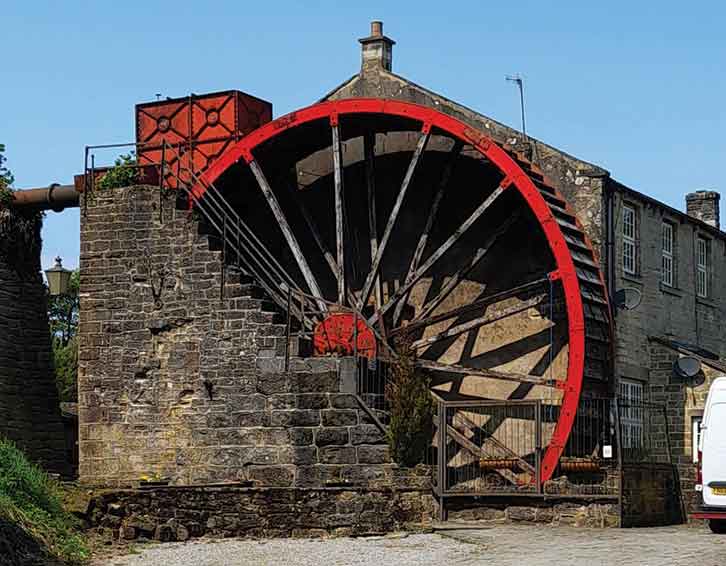
We then backtracked and walked along the road until we came to another pub, on the other side of the river, The Sportsman’s Arms (also sadly closed!). So we found a further path and continued our pleasant riverside walk back to Pateley Bridge.
After lunch, we decided to stroll along beside the river again, this time enjoying a relaxing walk past Harefield Hall, an impressive building that once belonged to the Archbishop of York and is rumoured to have been owned by Henry VIII – it’s now a popular hotel and restaurant.
The path eventually brings you to the lake at Glasshouses Mill. The mill is now smart residential properties, but there have been buildings here for hundreds of years.
In the 14th century, Glasshouses was mentioned in a medieval manuscript from nearby Fountains Abbey, referring to the glass for the abbey, so it is assumed that this was where the glass was produced.
By the 17th century, it was a corn mill and in the 19th century, a linen and flax mill. It would have employed hundreds of people until it closed in 1907.
In 1912 it was purchased again, and this time was used to produce rope and hawsers for the Royal Navy during World War I and camouflage netting in World War II.
Beautiful surroundings
After our explorations at the mills, we walked back to town and then along the now familiar footpath to the campsite.
Pateley Bridge had certainly done its job, and provided us with plenty of relaxation in beautiful, peaceful surroundings.
Looking around at the glorious scenery here, it is hard to imagine that in the past, this was a thriving centre of industry, with hundreds of workers employed in the mills and then later, when the nearby reservoirs were built, people and equipment passing through on their way to the construction sites. A weekend was not enough, and we plan to return and explore more of the footpaths in this lovely area again soon.
Looking for some inspiration for where to embark on some seasonal strolls? Then check out our pick of the best winter walks.
You may also like:
- Find out how Elaine and Joe Ormerod got on when they set off on a tour to Newark and the surrounding area, discovering the turbulent history of the area.
Where we stayed
Riverside Caravan Park
- Address: Low Wath Road, Pateley Bridge HG3 5HL
- Open: 31 March to 31 October
- Pitches: 97
- Prices: From £26
This pleasant family-run site is within easy walking distance of the town centre, close enough for the shops but far enough to offer a relaxing atmosphere. The rural location provides superb views, with pretty walks along the River Nidd and in the surrounding countryside.
When to go
The Yorkshire Dales have great appeal for visitors in all seasons, particularly if you enjoy hiking and other outdoor pursuits, but the region can get very busy in high summer. Spring and autumn are ideal times to visit
Find out more
- Welcome to Nidderdale
- Nidderdale AONB
- Visit Pateley Bridge
- St Mary’s Church
- Pateley Bridge Heritage Trails and other walks
- DalesBus services
- Welcome to Grassington
Lead image: Getty Images
If you’ve enjoyed reading this article, why not get the latest news, reviews and features delivered direct to your door or inbox every month. Take advantage of our brilliant Practical Caravan magazine SUBSCRIBERS’ OFFER and SIGN UP TO OUR NEWSLETTER for regular weekly updates on all things caravan related.

